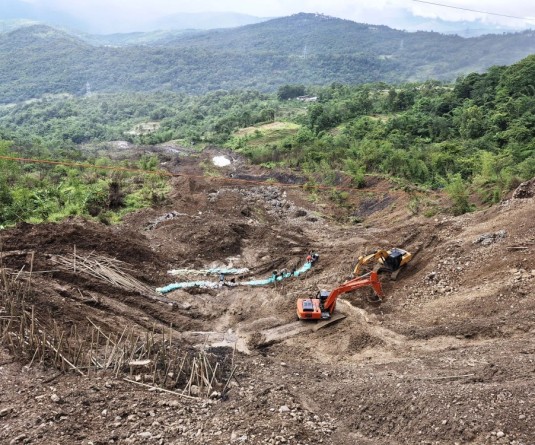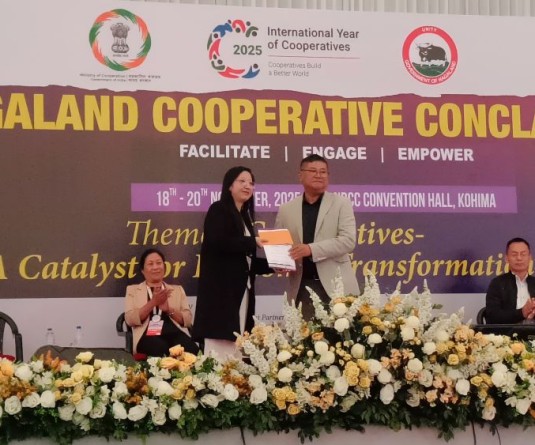
Chizokho Vero
Kohima | May 22
Nagaland is host to biologically diverse and unique species like Tragopan, Mithun, Naga hottest chilli, tallest rhododendron, tallest paddy rice, rare and threatened orchid- Red panda, Bulbophyllum, wild rose, wild pepper etc.
“Even though Nagaland has very small land mass, the diversity of plants and animals is enormous because it can find tropical wet evergreen forests to temperate forest- Alpine, grassland, jhum regrowth and bamboo forests,” said I. Panger Jamir (IFS), PCCF & HoFF, Forest, Environment & Climate Change, during the International Day for Biological Diversity (May 22) here under theme ‘Biodiversity and sustainable tourism.’ It was held under the aegis of Nagaland State Biodiversity Board (NSBB).
Nagaland is a part of the Indo-Burma biodiversity hot spot because of its rich biological resources.
The State has recorded floral diversity of about 2400 species of angiosperms, 9 species of gymnosperms, 340 species of orchids, 22 species of bamboo. The faunal recorded diversity includes more than 100 species of mammals, 400 species of birds and a good number of reptiles and amphibians.
Jamir said our responsibility is to preserve and protect biodiversity, and reduce pressure on the biodiversity by protecting endangered species.
“Unless we act now it may be too late for next generation to survive,” he said, challenging young minds to focus on conservation of the fragile ecosystem that hosts biodiversity on planet earth.
He said the role of forests is not only to provide resources for human survival but are vital for social, cultural, historical, economic and industrial development and to maintain ecological balance.
Jamir informed although India has only 2.4% of the world’s land area, its share of the global species diversity is 8.1%. Nearly 45,000 plants species and twice as many as animal species have been recorded from the Union.
He added that the most biological diversity in India is found in the North East and Western Ghats.
It is estimated that tropical deforestation may result in the loss of upto 15% species by 2020. He said community biodiversity conservation efforts in the State have started, citing examples like Sendenyu, Kanglatu, Dikhu green zone and Khonoma nature conservation.
NSBB chairman T. Lotha, IFS (Rtd) said the existence of humanity depends on biodiversity. The theme ‘Biodiversity and sustainable tourism’ was chosen to coincide with the UN General Assembly’s observance of 2017 as the International Year of Sustainable Tourism for Development.
Celebration of International Day of Biological Diversity provides an opportunity to raise awareness and action towards the contribution of sustainable tourism to economic growth, conservation and sustainable use of biodiversity. He said when we talk about diversity, we are talking about livelihood, economy, environment and social and cultural aspects. He also stated that globally, more than 1.30 billion people depend on the ecosystem.
Species and ecosystem biodiversity play an important role for eco-tourism.
Lotha suggested that the areas/habitats where Asian elephant, Mithun, Tragopan are found in Nagaland should be developed for ecotourism.
He said for sustainable tourism, one has to ensure the optimum use of natural resources, viability of economy and viability of stakeholders like host community.
“We have to preserve our forest so that we can sustain our life,” said H. Singson, Joint Secretary, Forest, Environment and Climate Change, Government of Nagaland.
NSBB member Prof. Sapu Changkija maintained that North East India is one of 25 biodiversity hotpots in the world, adding that it possesses the richest medicinal plants, orchids, birds, snakes and the highest variety of ornamental fishes.
Prof. Changkija encouraged students to be aware of the rich biodiversity in the State and become “nature lovers”.
Some prospects of sustainable eco-tourism in Nagaland
Khonoma
Khonoma known as “The Green Village” is rich in various species of flora and fauna and is famous for its forest and unique form of agriculture practices. The state bird “Tragopan blythii, is reportedly found here. The Khonoma Nature Conservation & Tragopan Sanctuary, conserves a large variety of rare species of plants and animals within its 25 sq.km.
Doyang Hydro Project, Wokha & the Amur Falcon conservation
Doyang Hydro Project with a capacity of 75 MW is built on the river Doyang. It is a home of varieties of fishes which are preserved. There exist numerous mini and small islands. Over the years, these places have become the roosting place of migratory bird- Amur Falcon, known to be one of the world’s longest- distance migratory birds as they travel upto a staggering 22, 000 km a year. These birds migrate from Mongolia, Siberia, Northern China and Japan to Doyang Hydro Project in October- November.
Mount Saramati
Mount Saramati, the highest mountain range of Nagaland is in the extreme east of state bordering Myanmar. It stands at 3862m above sea level and is listed in top 6th highest mountain peaks of India, renowned as “The Jewels of India” considering it as the pride of India.
Japfu peak
Japfu peak, with a height of 3048m above sea level is the second highest peak of Nagaland. The world’s biggest and tallest Rhododendron tree discovered in 1993 featured in the Guinness Book of World Records, measures upto 108 feet and can be found at the base of Japfii peak.
Dzükou valley
Dzükou valley popularly known as “Valley of flowers of the North East.” The valley is famous for Dzükou lily, and is one of the most beautiful and mesmerizing trekking and hiking spot in the north eastern states of India.
Shilloi lake
Shilloi Lake is the largest natural lake in Nagaland, covering an area of 250-300 sq.m. This lake resembles the shape of a human footprint.
Puliebadze Wildlife Sanctuary
Puliebadze Wildlife Sanctuary is a place of thrill for those looking for an adventurous wildlife journey, surrounded by beautiful hills and streams. The high hill of the sanctuary is home to rare bird species such as Tragopan blythii.






